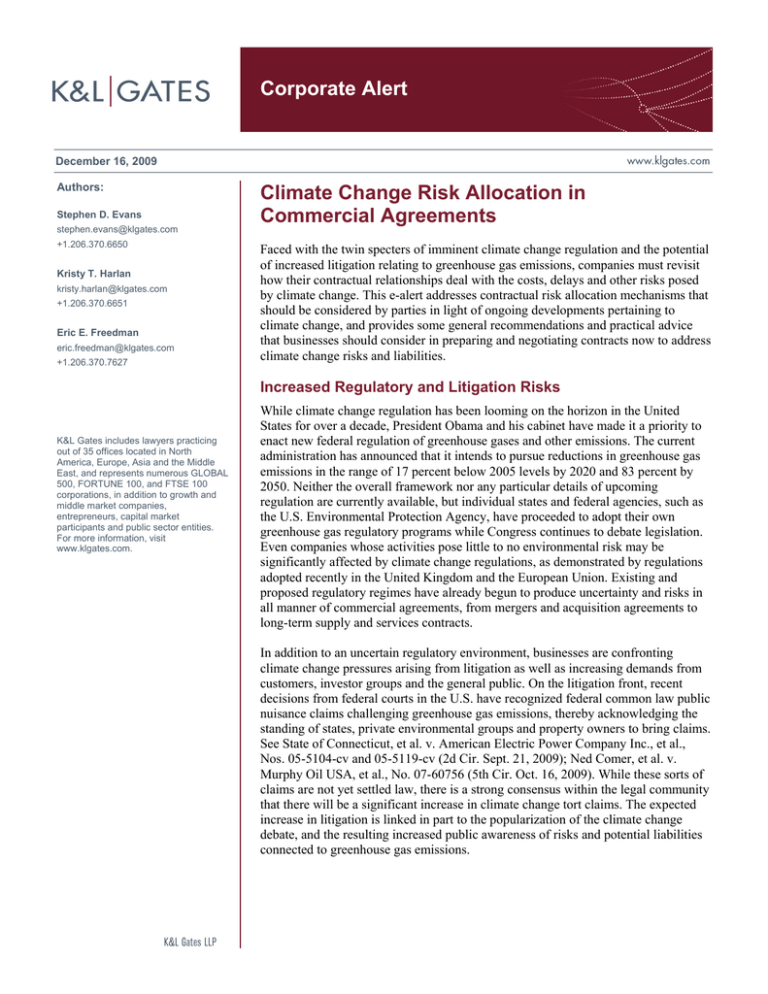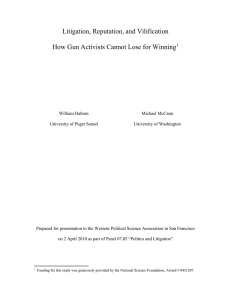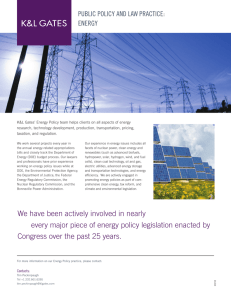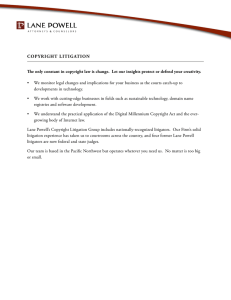
Corporate Alert
December 16, 2009
Authors:
Stephen D. Evans
stephen.evans@klgates.com
+1.206.370.6650
Kristy T. Harlan
kristy.harlan@klgates.com
+1.206.370.6651
Eric E. Freedman
eric.freedman@klgates.com
+1.206.370.7627
Climate Change Risk Allocation in
Commercial Agreements
Faced with the twin specters of imminent climate change regulation and the potential
of increased litigation relating to greenhouse gas emissions, companies must revisit
how their contractual relationships deal with the costs, delays and other risks posed
by climate change. This e-alert addresses contractual risk allocation mechanisms that
should be considered by parties in light of ongoing developments pertaining to
climate change, and provides some general recommendations and practical advice
that businesses should consider in preparing and negotiating contracts now to address
climate change risks and liabilities.
Increased Regulatory and Litigation Risks
K&L Gates includes lawyers practicing
out of 35 offices located in North
America, Europe, Asia and the Middle
East, and represents numerous GLOBAL
500, FORTUNE 100, and FTSE 100
corporations, in addition to growth and
middle market companies,
entrepreneurs, capital market
participants and public sector entities.
For more information, visit
www.klgates.com.
While climate change regulation has been looming on the horizon in the United
States for over a decade, President Obama and his cabinet have made it a priority to
enact new federal regulation of greenhouse gases and other emissions. The current
administration has announced that it intends to pursue reductions in greenhouse gas
emissions in the range of 17 percent below 2005 levels by 2020 and 83 percent by
2050. Neither the overall framework nor any particular details of upcoming
regulation are currently available, but individual states and federal agencies, such as
the U.S. Environmental Protection Agency, have proceeded to adopt their own
greenhouse gas regulatory programs while Congress continues to debate legislation.
Even companies whose activities pose little to no environmental risk may be
significantly affected by climate change regulations, as demonstrated by regulations
adopted recently in the United Kingdom and the European Union. Existing and
proposed regulatory regimes have already begun to produce uncertainty and risks in
all manner of commercial agreements, from mergers and acquisition agreements to
long-term supply and services contracts.
In addition to an uncertain regulatory environment, businesses are confronting
climate change pressures arising from litigation as well as increasing demands from
customers, investor groups and the general public. On the litigation front, recent
decisions from federal courts in the U.S. have recognized federal common law public
nuisance claims challenging greenhouse gas emissions, thereby acknowledging the
standing of states, private environmental groups and property owners to bring claims.
See State of Connecticut, et al. v. American Electric Power Company Inc., et al.,
Nos. 05-5104-cv and 05-5119-cv (2d Cir. Sept. 21, 2009); Ned Comer, et al. v.
Murphy Oil USA, et al., No. 07-60756 (5th Cir. Oct. 16, 2009). While these sorts of
claims are not yet settled law, there is a strong consensus within the legal community
that there will be a significant increase in climate change tort claims. The expected
increase in litigation is linked in part to the popularization of the climate change
debate, and the resulting increased public awareness of risks and potential liabilities
connected to greenhouse gas emissions.
Corporate Alert
Short-Term Contract Risk Allocation
Representations and Warranties. In asset and equity
purchase and sale agreements, the most common and
traditional means of addressing the risks of liability
is through the representations and warranties made
by each party, taking into account any disclosure
schedules that may supplement or qualify those
representations. The parties typically represent and
warrant to each other their compliance with laws in
effect as of signing and closing of the transaction.
Given the rapidly changing nature of climate change
law, however, as evidenced by the recent sequence
of federal court decisions and regulatory orders
described above, it can be difficult at any time to
ascertain the current state of climate change law, and
therefore to assess the full implications of potentially
relevant representations and warranties.
Anticipated risks, such as new environmental
regulation or an expanded list of contaminants, are
normally beyond the scope of representations and
warranties. An exception to this general rule is when
the parties have a relatively high degree of certainty
as to impending events, such as when a new piece of
legislation is in its final stages but is not yet in force,
or when a regulation has become effective but is
subject to a transition period or the issuance of
guidelines or interpretive rulings from an applicable
regulatory authority. In such circumstances,
contractual representations may appropriately speak
as to the parties’ expected compliance with proposed
legislation, qualified by their current knowledge and
understanding. The drawbacks of this approach are
obvious: the representations will be limited to the
parties’ knowledge at the time of signing and
closing, and may not accurately deal with the
ultimate form of the regulation.
Covenants. A typical commercial contract will also
contain a number of covenants, which govern the
conduct of both parties during the period between
signing and closing of the transaction, as well as
their conduct following the closing. The covenants
relating to the period between signing and closing
generally focus on maintaining the applicable
business or assets in their current state until closing.
Typically the parties agree to act as they would in
the ordinary course of business, in a manner
consistent with past practice and in accordance with
“Applicable Law” as defined in the contract. For
purposes of climate change regulation and risk
allocation, these pre-closing period covenants raise
several questions. Will the parties have the
particular foresight to address climate change
regulation in the definition of Applicable Law?
Should the parties specifically account for costs,
delays and other liabilities associated with
regulatory compliance should there be a change in
law between signing and closing? Will conducting a
defense against greenhouse gas emissions litigation
be considered to be within the ordinary course of
business and consistent with past practice? Similar
questions arise with respect to covenants that
continue in effect after closing, such as where the
parties have committed to longer-term cooperation
or where payments to a seller depend upon the postclosing financial performance of the assets or
business being sold. In these situations, a seller is
likely to insist that the buyer has assumed the risks
and liabilities associated with new climate change
laws and regulations, even if those risks and
liabilities may have been foreseeable as of the
closing. Conversely, a buyer may well argue that
seller’s right to payment should be reduced to
reflect the costs and liabilities imposed by new but
reasonably foreseeable climate change legal risks.
Indemnification. Contracts generally rely upon
indemnification provisions to provide specific
allocation of risks for breach of the contract
representations, warranties and covenants. In a
typical sale transaction, a seller may indemnify the
buyer for a limited period of time after the closing
for any claims relating to breaches of the seller’s
representations, warranties or covenants, up to a
specified maximum amount. Whether a seller’s
indemnification will be an adequate remedy to deal
with climate change compliance costs or litigation
claims is an open question in the context of the
currently uncertain landscape. The indemnification
period for breach of representations and warranties
often expires only a year or two after the closing.
Depending upon the risk tolerance of the parties, the
agreement could provide for a longer
indemnification period (or higher caps on
indemnifiable amounts) for claims relating
specifically to climate change or greenhouse gas
emissions lawsuits from third parties. But the
effectiveness of the indemnification provisions will
be predicated on the precise language of the
representations, warranties, and covenants. If they
December 16, 2009
2
Corporate Alert
fail adequately to encompass potential changes in, or
changes in the interpretation or application of,
climate change laws or regulations or litigation
claims, it is unlikely that any contractual duty to
indemnify would apply.
Whether or not the parties will insist upon -- or even
consider -- modifying their contracts to deal with the
concerns outlined above will probably turn on the
likelihood of the risk that new regulation or
litigation pose to the parties, coupled with the likely
magnitude of the liability resulting from such risk.
Two internet companies signing a contract today
may appear to have little need to dwell on such risks,
whereas two power companies engaging in a longterm power supply agreement may find themselves
embroiled with the task of predicting the likelihood
of litigation or regulation as well as the potential
resulting exposure.
The parties risk having too much (or too little)
variance in pricing, injecting a potentially
unacceptable level of uncertainty and variation
for a long-term contract, where stability is most
favored.
•
Change in Law Provisions: These provisions
typically provide that in the event of certain
changes in laws, such as changes in
environmental or tax laws or regulations, the
affected party (usually the seller) will have the
right to require that the other party share in the
increased costs. The provisions often establish
cost-sharing between the parties on a pre-agreed
basis, usually after some threshold in cost
increases has been exceeded, but may instead
require that the parties renegotiate the contract
in good faith to take account of the effects of
new laws or regulations. Parties should consider
whether a change in greenhouse gas regulation
would constitute a change in law under their
agreements. A generic change of law provision
may not fully address the possible business
costs of a new climate change regime and
attendant delays in implementation and
research.
•
Cost Pass-Through: A supplier in a long-term
contract may have the ability, subject to agreedupon thresholds and limits, to pass on its
unforeseen additional costs to the purchaser. In
the context of climate change, new carbon taxes
or regulatory compliance costs or greenhouse
gas-related litigation pose a particular
challenge. Will a given pass-through provision
adequately define what sorts of new technology
or compliance expenses are appropriately
passed on, which a typical pass-through
provision would not permit? Will the provision
speak as to how frequently prices may be
adjusted? Will the provision require the supplier
to obtain replacement sources of supply or
otherwise restructure its operations to mitigate
the impact of new regulation before passing on
new costs? Are the costs of defending a
nuisance suit the sort of expense that can be
passed on to the purchaser, if the suit stems
from the production of goods produced solely
for the purchaser? As these provisions become
Long-Term Contract Risk Allocation
Long-term agreements are typical in many contexts - especially in supply arrangements, such as sales of
energy and natural resources -- as a means of
ensuring a reliable supply and steady return on
investment. The contractual stability and
predictability that are characteristically sought by
parties to a long-term arrangement are frustrated
where there is a likelihood of changes in the
regulatory environment or litigation landscape.
Fundamentally, the parties’ exposure to climate
change risk will depend in part on the extent to
which their ongoing arrangements address the
possibility that the original bargained-for transaction
may be significantly altered by a change in
circumstances. A long-term contract will typically
allocate this risk through a combination of pricing,
change in law and pass-through provisions.
•
Pricing Changes: Long-term contracts often
provide for the parties to revise pricing
structures, many times automatically, in light of
changed costs and circumstances – within
certain parameters and subject to maximum and
minimum thresholds. But in the context of
impending climate change regulation, it is
difficult to predict how the market will respond
to any new regulatory framework, especially
when the form and implementation of the new
framework are unknown at the time of signing.
December 16, 2009
3
Corporate Alert
increasingly complicated, parties should be sure
to include a clear and robust dispute-resolution
system, providing for expert assessments and
ongoing audit rights.
Parties may also consider resorting to other clauses
in their agreements for potential relief should their
businesses be adversely affected by climate change
developments. For example, a force majeure clause
typically excuses a party from performing under the
contract upon the occurrence of an unforeseen and
uncontrollable event that falls within the provision.
While governmental acts can sometimes constitute
force majeure, it is unlikely that climate change
regulation (or, for that matter, climate change
lawsuits) would be deemed sufficiently
unforeseeable at this point to fall within the scope of
a force majeure clause, unless the agreement was
entered into some time ago. Similarly, a party may
seek to invoke a material adverse change clause in
an agreement, claiming that increased regulatory
burdens, increased compliance costs, unavailability
of financing, litigation costs or other costs related to
climate change have resulted in a material adverse
effect on its business. Depending upon the language
of the applicable provision, the occurrence of a
material adverse change could excuse performance
or provide grounds for terminating the agreement.
That said, developments in climate change
regulation would not constitute a material adverse
change under most such provisions. Regulatory
changes having a general and widespread effect
within an industry are often specifically excluded
from the definition of material adverse change, and
climate change regulatory developments are
unlikely to have a disproportionate impact on a
single greenhouse gas-emitting company as
compared to all similarly situated companies.
What to Do Now
As a preliminary matter, companies need to
determine the extent to which their operations and
business arrangements are likely to be affected by
climate change regulation and litigation. This
assessment can be a daunting task, since the full
extent of such risks and liabilities is not yet known.
Companies should nevertheless attempt to identify
vulnerable areas of their business and those
customers and suppliers that may experience
increased costs, delays or service interruptions as a
result of climate change regulation and litigation.
From there, companies should confer with business
partners and counsel to develop preferred
approaches for dealing with climate change
regulatory and litigation risks in contracts. A
consistent approach to the contractual provisions
discussed above will be an important factor in
determining ongoing levels of risk and liability.
Finally, businesses should review their standard
contractual terms to ensure that climate change risks
and liabilities are specifically addressed to the
extent possible.
Anchorage Austin Beijing Berlin Boston Charlotte Chicago Dallas Dubai Fort Worth Frankfurt Harrisburg Hong Kong London
Los Angeles Miami Moscow Newark New York Orange County Palo Alto Paris Pittsburgh Portland Raleigh Research Triangle Park
San Diego San Francisco Seattle Shanghai Singapore Spokane/Coeur d’Alene Taipei Tokyo Washington, D.C.
K&L Gates includes lawyers practicing out of 35 offices located in North America, Europe, Asia and the Middle East, and represents numerous
GLOBAL 500, FORTUNE 100, and FTSE 100 corporations, in addition to growth and middle market companies, entrepreneurs, capital market
participants and public sector entities. For more information, visit www.klgates.com.
K&L Gates is comprised of multiple affiliated entities: a limited liability partnership with the full name K&L Gates LLP qualified in Delaware and
maintaining offices throughout the United States, in Berlin and Frankfurt, Germany, in Beijing (K&L Gates LLP Beijing Representative Office), in
Dubai, U.A.E., in Shanghai (K&L Gates LLP Shanghai Representative Office), in Tokyo, and in Singapore; a limited liability partnership (also named
K&L Gates LLP) incorporated in England and maintaining offices in London and Paris; a Taiwan general partnership (K&L Gates) maintaining an
office in Taipei; a Hong Kong general partnership (K&L Gates, Solicitors) maintaining an office in Hong Kong; and a Delaware limited liability
company (K&L Gates Holdings, LLC) maintaining an office in Moscow. K&L Gates maintains appropriate registrations in the jurisdictions in which its
offices are located. A list of the partners or members in each entity is available for inspection at any K&L Gates office.
This publication is for informational purposes and does not contain or convey legal advice. The information herein should not be used or relied upon
in regard to any particular facts or circumstances without first consulting a lawyer.
©2010 K&L Gates LLP. All Rights Reserved.
December 16, 2009
4



